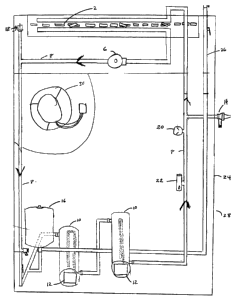Une partie des informations de ce site Web a été fournie par des sources externes. Le gouvernement du Canada n'assume aucune responsabilité concernant la précision, l'actualité ou la fiabilité des informations fournies par les sources externes. Les utilisateurs qui désirent employer cette information devraient consulter directement la source des informations. Le contenu fourni par les sources externes n'est pas assujetti aux exigences sur les langues officielles, la protection des renseignements personnels et l'accessibilité.
L'apparition de différences dans le texte et l'image des Revendications et de l'Abrégé dépend du moment auquel le document est publié. Les textes des Revendications et de l'Abrégé sont affichés :
| (12) Demande de brevet: | (11) CA 2458248 |
|---|---|
| (54) Titre français: | SYSTEME DE CHAUFFAGE |
| (54) Titre anglais: | HEATING SYSTEM |
| Statut: | Morte |
| (51) Classification internationale des brevets (CIB): |
|
|---|---|
| (72) Inventeurs : |
|
| (73) Titulaires : |
|
| (71) Demandeurs : |
|
| (74) Agent: | WRAY, ROBERT WILLIAM |
| (74) Co-agent: | |
| (45) Délivré: | |
| (22) Date de dépôt: | 2004-02-18 |
| (41) Mise à la disponibilité du public: | 2005-08-18 |
| Licence disponible: | S.O. |
| (25) Langue des documents déposés: | Anglais |
| Traité de coopération en matière de brevets (PCT): | Non |
|---|
| (30) Données de priorité de la demande: | S.O. |
|---|
The present invention involves a radiator/hot water heating system (electric)
within a traditional
forced-air furnace housing, which is connected to the existing central air
ductwork of a building.
The radiator/hot water heating system uses a single radiator which is
connected to one or more
4" pipes through which water is heated by means of electricity. The entire
heating system
contains approximately 3 gallons of water. A fan circulates heat from the
radiator through-out the
building.
Note : Les revendications sont présentées dans la langue officielle dans laquelle elles ont été soumises.
Note : Les descriptions sont présentées dans la langue officielle dans laquelle elles ont été soumises.

Pour une meilleure compréhension de l'état de la demande ou brevet qui figure sur cette page, la rubrique Mise en garde , et les descriptions de Brevet , États administratifs , Taxes périodiques et Historique des paiements devraient être consultées.
| Titre | Date |
|---|---|
| Date de délivrance prévu | Non disponible |
| (22) Dépôt | 2004-02-18 |
| (41) Mise à la disponibilité du public | 2005-08-18 |
| Demande morte | 2007-02-19 |
| Date d'abandonnement | Raison | Reinstatement Date |
|---|---|---|
| 2005-05-24 | Absence de réponse à la lettre du bureau | 2006-05-23 |
| 2006-02-20 | Taxe périodique sur la demande impayée |
| Type de taxes | Anniversaire | Échéance | Montant payé | Date payée |
|---|---|---|---|---|
| Le dépôt d'une demande de brevet | 200,00 $ | 2004-02-18 | ||
| Enregistrement de documents | 100,00 $ | 2006-05-23 | ||
| Rétablissement - absence de réponse à la lettre du bureau | 200,00 $ | 2006-05-23 | ||
| Paiement des arriérés de taxes | 50,00 $ | 2007-02-19 |
Les titulaires actuels et antérieures au dossier sont affichés en ordre alphabétique.
| Titulaires actuels au dossier |
|---|
| FOURNIER LACELLE, JOCELYNE |
| Titulaires antérieures au dossier |
|---|
| LACELLE, JEAN-GUY |